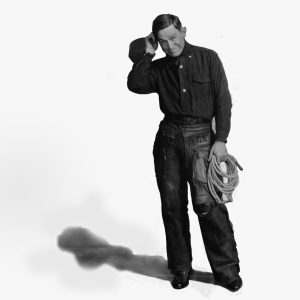
Will Rogers was the world’s first multi-media celebrity, and is still one of the greatest humanitarians, philanthropists, and entertainers who ever lived. He achieved it all by remaining true to his common Oklahoma roots.
Will was born in Indian Territory, the future Oklahoma, November 4, 1879, on a ranch between Claremore and Oolagah. He was of Scotch-Irish-Cherokee ancestry, his parents’ eighth child and only son.
Will worked cattle and became an excellent horseman, then dropped out of 10th grade to be a full-time cowboy. He was so good with a lasso that he became an expert at rope tricks. He’s in the Guinness Book of World Records for throwing three lassos at once, one around a moving horse’s neck, one around the rider, and the third around all four of the horse’s legs.
In 1902, Will started his world travels, doing rope tricks with Texas Jack’s Wild West Show and the Wirth Brothers Circus. He appeared at the St. Louis World’s Fair and in New York City. During a 1905 rodeo at Madison Square Garden, when a runaway steer terrified the crowd, he roped it, and suddenly had the attention of newspapers and radio stations across the country.
He traveled America, Canada, and Europe with the Ziegfeld Follies for 10 years, and during that period made two major changes in his life. He married Betty Blake, and they would have four children, Will Jr., Mary, Jim, and Fred. Also, along with his rope tricks, he started talking, spinning his unique brand of down home stories and jokes, and his audiences loved it more than his rope tricks. They especially liked his unique talent for good-natured jokes about politicians and the government.
In 1918, Will began acting in silent films, but his movie career took off with the advent of “talkies.” The public couldn’t get enough of his voice and the smile that always seemed to tug at the corner of his mouth. Will starred in 71 films, was the highest-paid actor in Hollywood, and in 1934 was voted the most popular male actor in Hollywood.
New Year’s Eve, 1922, he wrote his first newspaper column. His curiosity, keen observations, and wry wisdom filled 4,000 syndicated columns that were carried in over 500 newspapers. He wrote six books, and in 1930 began his radio show. In an era of more eloquent speakers and bombastic announcers, Will’s voice was unique, and he always made his listeners feel that he was one of them. Will and Betty traveled the world, often using his celebrity to raise support for people in need, including victims of natural disasters in other countries. He was a guest at the White House and a friend of presidents Calvin Coolidge and Franklin Roosevelt.
Will was enthralled with aviation, knew it was the future of travel, promoted it to the public, and flew whenever he could. In 1935, on a trip with pioneering pilot Wiley Post to survey air routes to Russia, they were both killed when their plane crashed on takeoff at Point Barrow, Alaska.
Betty built the Will Rogers Memorial in Claremore in 1938, the same year Will Rogers High School was built in Tulsa.
Today, a statue of Will represents Oklahoma in the National Statuary Hall at the Capitol Building in Washington, D. C. His humor and political observations are as relevant as when he first spoke and wrote them. His legacy includes a musical, The Will Rogers Follies, a one-man play, Will Rogers, USA, and Will Rogers Motion Picture Pioneers Foundation, an entertainment industry charity that also manages the Will Rogers Institute, a research center for cardiopulmonary disease.
